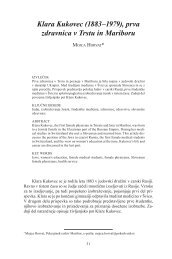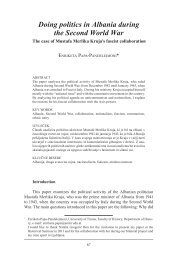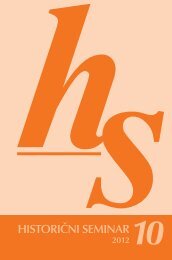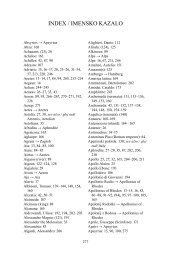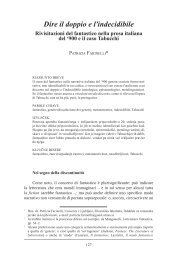The Invention of Modern Aesthetics: From Leibniz to Kant
The Invention of Modern Aesthetics: From Leibniz to Kant
The Invention of Modern Aesthetics: From Leibniz to Kant
Create successful ePaper yourself
Turn your PDF publications into a flip-book with our unique Google optimized e-Paper software.
<strong>The</strong> <strong>Invention</strong> <strong>of</strong> <strong>Modern</strong> <strong>Aesthetics</strong>: <strong>From</strong> <strong>Leibniz</strong> <strong>to</strong> <strong>Kant</strong><br />
holding <strong>of</strong> explicit judgment was deemed appropriate and allusion and<br />
suggestion was more apposite; it was thus connected with l’esprit de<br />
inesse as contrasted with l’esprit de géometrie, but it was also used <strong>to</strong><br />
refer <strong>to</strong> situations when certain phenomena were perceived <strong>to</strong> be »beyond<br />
words«, <strong>to</strong> be ineffable. 20 <strong>The</strong> expression »je ne sais quoi«, has<br />
two sources, one »in an urbane nescio quid <strong>of</strong> Cicero«, the other one<br />
in »the nescio quid <strong>of</strong> mystical ineffability going back <strong>to</strong> Augustine«,<br />
Barnouw maintains referring <strong>to</strong> the work <strong>of</strong> the his<strong>to</strong>rian <strong>of</strong> ideas,<br />
Erich Köhler. 21 <strong>The</strong> interest in the present context <strong>of</strong> l’esprit de inesse<br />
and the apprehension <strong>of</strong> qualities dificult <strong>to</strong> discern, those that elicit<br />
the »je ne sais quoi« lies in the fact that the exercise <strong>of</strong> the l’esprit de<br />
inesse requires personal qualities similar <strong>to</strong> the ones characteristic <strong>of</strong><br />
Baumgarten’s felix aestheticus, a matter I will return <strong>to</strong> in a while.<br />
<strong>The</strong> senses provide us, according <strong>to</strong> <strong>Leibniz</strong>, with acquaintance<br />
<strong>of</strong> colours, lavours, and the qualities <strong>of</strong> <strong>to</strong>uch, but the senses<br />
»do not make us know what these sensible qualities are or in what<br />
they consist«, as he puts it in a letter <strong>to</strong> Queen Charlotte <strong>of</strong> Prussia<br />
in 1702. 22 We do not actually perceive what a colour such as red is in<br />
reality although we are able <strong>to</strong> recognize red, since red may well be<br />
»the revolving <strong>of</strong> certain small globules«, which are imperceptible. 23<br />
Perceived colours cannot be deined, or, <strong>to</strong> put it in <strong>Leibniz</strong>’s language,<br />
we cannot account for the marks <strong>of</strong> the colour blue, for example, since<br />
»marks <strong>to</strong> recognize blue […] could not be given if we had never seen<br />
it«. 24 Blue is its own mark, <strong>Leibniz</strong> claims, »[i]t is an I know not what<br />
<strong>of</strong> which we are conscious, but for which we cannot account«. 25 Our<br />
knowledge <strong>of</strong> sensible qualities such as blue is clear and at the same<br />
time confused, the concept <strong>of</strong> the sensible quality blue is clear but not<br />
distinct since it cannot be deined by means <strong>of</strong> necessary and suficient<br />
properties (marks). In his posthumously published treatise, Nouveaux<br />
essais sur l’entendement humain, a systematic, critical commentary<br />
on Locke’s Essay Concerning Human Understanding (1690), 26 Leib-<br />
20<br />
Ibid., pp. 61–62. <strong>The</strong> distinction between l’esprit de inesse and l’esprit de géometrie<br />
was famously formulated by Blaise Pascal in the Pensées sur la religion, posthumously<br />
published in 1670. <strong>The</strong> former meant apprehending things without rules and<br />
judgment, the latter judging things according <strong>to</strong> explicit rules and criteria.<br />
21<br />
Ibid., pp. 63–64.<br />
22<br />
G. W. <strong>Leibniz</strong>, Selections, ed. Philip P. Wiener (New York: Charles Scribner’s Sons,<br />
1951), p. 355.<br />
23<br />
Ibid.<br />
24<br />
Ibid., p. 357.<br />
25<br />
Ibid.<br />
26<br />
<strong>The</strong> Nouveaux essais sur l’entendement humain was composed in 1704–1705 but remained<br />
unpublished until 1765. One reason for the delay was Locke’s death in 1704,<br />
since one <strong>of</strong> <strong>Leibniz</strong>’s purposes in writing the work was <strong>to</strong> elicit a response from Locke.<br />
139




